HistoryThe first inhabitants were probably the Minonans, Cretans, followed by Dorians at the end of the 2nd Millennium BC. The first inhabitants probably called the island Telchinia. Rhodes was soon to become one of the most powerful islands with its strong military and commercial fleet. Initially, the island was forced to fight the Greeks along the Persian side during the Persian Wars in the 5th century BC, but managed to break free and became a member of the Athenian League. The Romans conquered Greece in the 2nd century BC, and for Rhodes this, and the following Byzantine era, was to be a period of decline. Pirates kept attacking, as well as Saracens and Arabs, and the Venetians occupied the island in the 11th century, followed by crusaders and Genovans, and finally the Turks in the 16th century. The most famous period was probably when the Knights of the Order of St. John (also known as the Knights of Malta or the Knights of Rhodes) ruled here, since there are still several buildings from this time. Rhodes is even referred to as the "Island of the Knights" sometimes. They came in 1309 and stayed until the Turks invaded in 1522. In 1912 Rhodes was given to Italy, and liberated in 1948. |
Biblical SignificanceThe island of Rhodes is mentioned once in the Old Testament (Ezekiel 27:15), once in the New Testament (Acts 21:1) and once in 1 Maccabees 15:23 In Ezekiel, Rhodes is listed as one of the nations that traded with Tyre. In Acts, the Apostle Paul is said to have stopped there in his journey to Jerusalem. According to local tradition, Paul's ship landed in a small harbor at Lindos, which is known today as St. Paul's Harbor. Another tradition suggests that Paul conducted missionary work on the island. The text of Acts, however, does not support either of these theories, "When we had departed from them and set sail, we came by a straight course to Kos, and the next day to Rhodes, and from there to Patara." (Some ancient authorities add "and Myra.") Notice that no point of landing is named, and the text seems to imply a departure from Rhodes without other incidents. Of course, it is entirely possible that the ship did
dock at Lindos, and Paul may have spent a brief time on Rhodes, but
there is no evidence of that. |
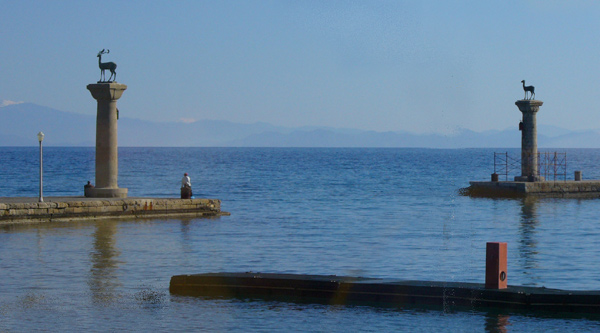 Early in the morning our ship docked in Rhodes, where we had a view of the harbor as shown in the header above.
Early in the morning our ship docked in Rhodes, where we had a view of the harbor as shown in the header above.
In a different harbor in Rhodes New Town, the Mandrani Harbor, a bronze doe and stag stand guard. Tradition has it that there is where the Colossus of Rhodes would have been.
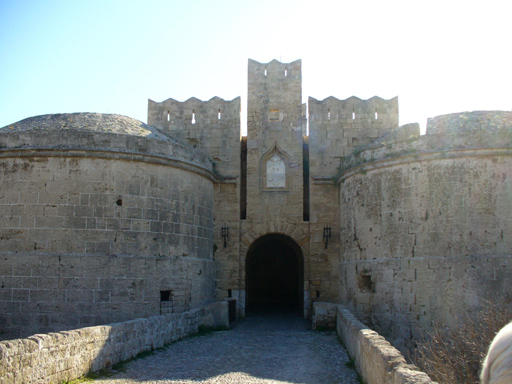 We entered the walls of the old city through one of its eleven gates.
We entered the walls of the old city through one of its eleven gates.
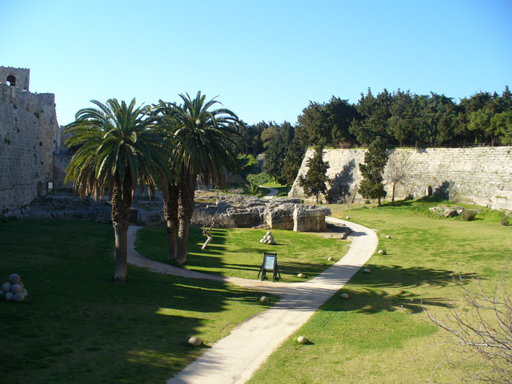
The medieval citadel here is surrounded by moats and 2.5 miles of walls.
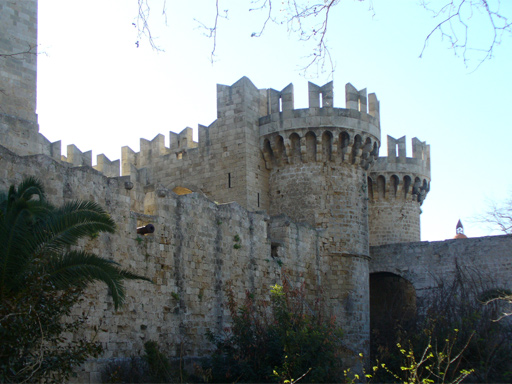 A fortress within a fortress, the Palace of the Grand Masters was the seat of the 19 Grand Masters of the Knights of Malta. Built in the 14th century, it survived earthquake and siege, but was blown up by an accidental explosion in 1856. It was restored by the Italians in the 1930s for Mussolini and King Victor Emmanuel III.
A fortress within a fortress, the Palace of the Grand Masters was the seat of the 19 Grand Masters of the Knights of Malta. Built in the 14th century, it survived earthquake and siege, but was blown up by an accidental explosion in 1856. It was restored by the Italians in the 1930s for Mussolini and King Victor Emmanuel III.
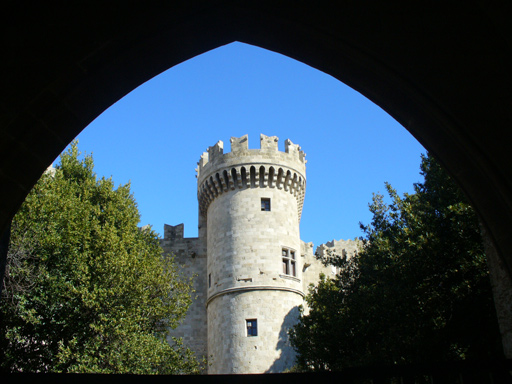 A view of one of the towers of the palace.
A view of one of the towers of the palace.
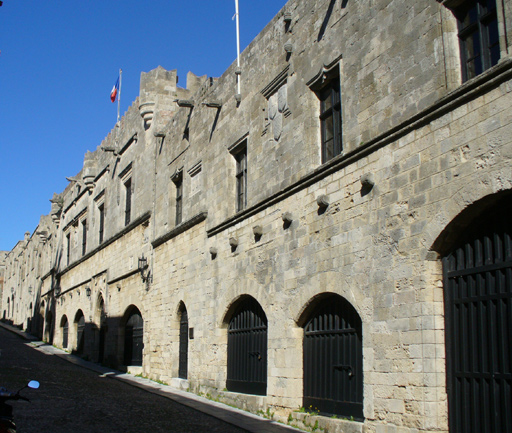 This is the street of the Knights, lined with the various Inns of the Tongues or nationalities of the Order of St. John. From the 15th and 16th centuries, these were used as meeting places for the Knights.
This is the street of the Knights, lined with the various Inns of the Tongues or nationalities of the Order of St. John. From the 15th and 16th centuries, these were used as meeting places for the Knights.
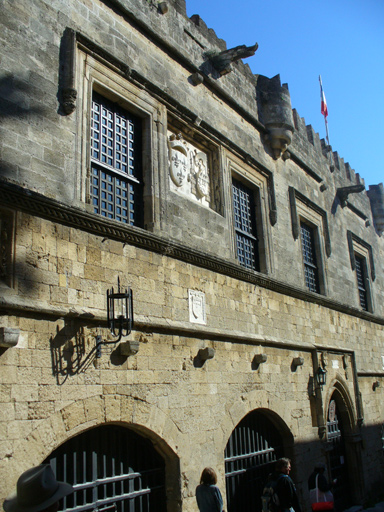 There was an Inn of Spain, an Inn of Provence,an Inn of Auvergne, an Inn of Italy and an Inn of France, which is shown here. The fleur-de-lys can be seen on the shield at the top center.
There was an Inn of Spain, an Inn of Provence,an Inn of Auvergne, an Inn of Italy and an Inn of France, which is shown here. The fleur-de-lys can be seen on the shield at the top center.
 This was originally a hospital, but now serves as a museum.
This was originally a hospital, but now serves as a museum.
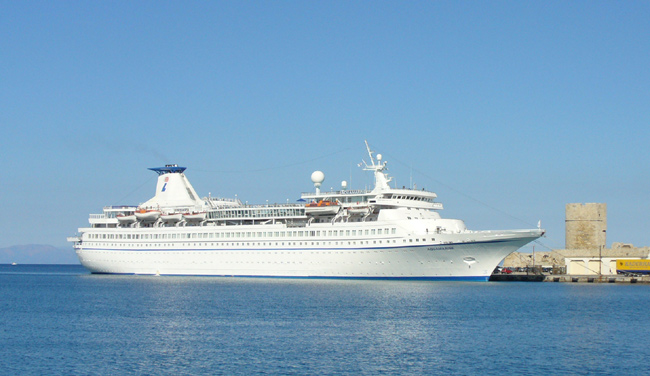 After our return from Lindos and lunch aboard ship, we walked around the city of Rhodes and had this view of our ship, the Aquamarine, in the harbor.
After our return from Lindos and lunch aboard ship, we walked around the city of Rhodes and had this view of our ship, the Aquamarine, in the harbor.
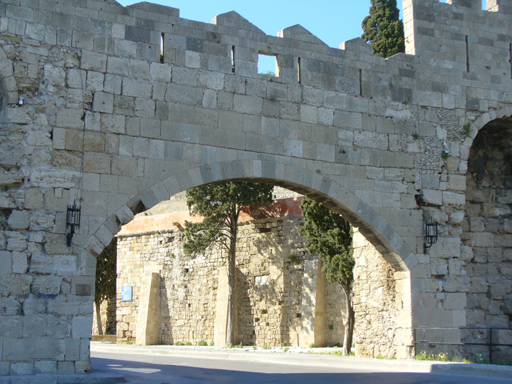 One of the interior walls of the city.
One of the interior walls of the city.
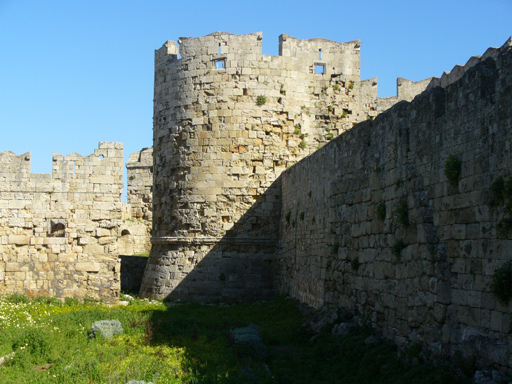 Another tower in the city wall.
Another tower in the city wall.
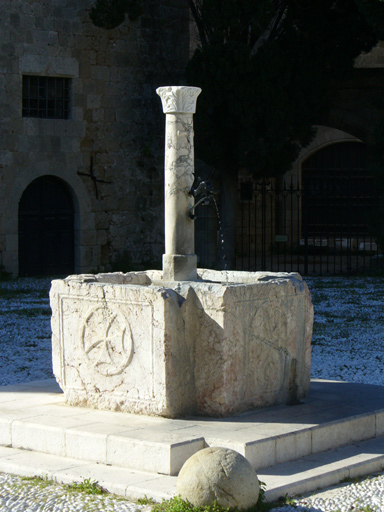 A fountain in a square with the Maltese crosses on the side.
A fountain in a square with the Maltese crosses on the side.
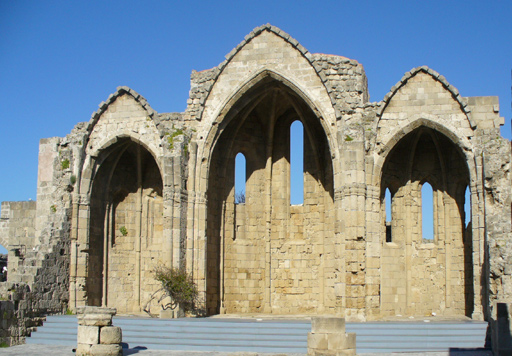 The church of Saint John which was built during the early 14th century and is dedicated to Saint John, patron of the Order.
It is a three-aisled church built according to the Gothic architectural style (during the Knights rule) and was used for the burial of Grand Masters.
The church of Saint John which was built during the early 14th century and is dedicated to Saint John, patron of the Order.
It is a three-aisled church built according to the Gothic architectural style (during the Knights rule) and was used for the burial of Grand Masters.
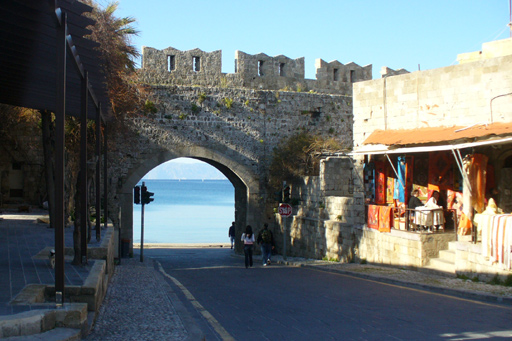 Another gate with one of the many shops in the Old City of Rhodes.
Another gate with one of the many shops in the Old City of Rhodes.
Some tour members also went to Lindos, but the whole group went to Patmos
